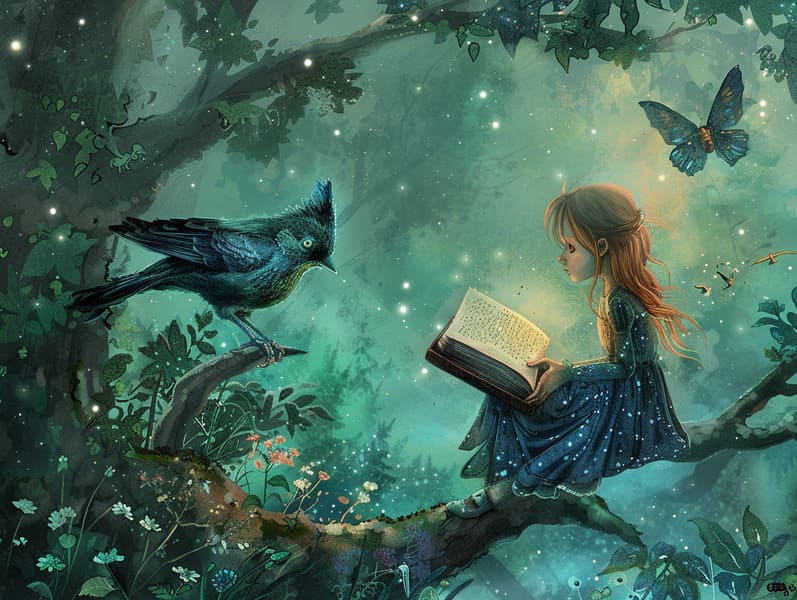
Legendary fairy tales have old origins. These narratives have been shared from one generation to the next long before they were ever inscribed. They came from a variety of traditions, including Asian traditions. They were initially passed along among elders, often carrying themes and messages relevant to the societal norms and beliefs of the time.
The Grimm brothers, Jacob and Wilhelm, were among the first to compile many of these beloved stories. Their volume, "Grimm's Fables," included classics like "The Little Glass Slipper," "Hansel and Gretel," and "Snow-White and Rose-Red," which have since become hallmarks in the world of iconic fairy tales. Similarly, Andersen's imaginative tales, such as "The Story of the Little Mermaid," and "The Ugly Duckling," have stolen hearts worldwide, solidifying their place in the pantheon of classic fairy tales.
Even though they are old, these tales remain as significant as ever, especially as children's night stories. These charming stories are now available in numerous formats, including colorful picture books, captivating animations, and online fairy tales.
Their lasting presence can be connected to several delightful features:
Key Lessons: Timeless fairy tales often convey important moral lessons. Fairy tales like "The Boy Who Cried Wolf" teach the benefit of integrity, while "The Hare and the Tortoise" stress the merits of perseverance and unpretentiousness. These stories offer little ones clear distinctions between ethical and unethical, shaping their moral compass in a soft yet meaningful way.
Warmth and Understanding: Fairy tales frequently feature heroines facing tests and troubles, fostering young listeners to resonate with their struggles and root for their triumphs. For instance, "Beauty and Her Beast" demonstrates the benefit of looking deeper to acknowledge the real person of a being, cultivating understanding and perception.
Cultural Recognition: Many classic fairy tales are imbued with the cultural contexts from which they emerged. Delving into these narratives can provide fascinating glimpses into different ways of life, strengthening a sense of world appreciation and discernment.
Creativity and Fantasy: The enchanted elements in old fairy tales—magical kingdoms—provoke children’s inventiveness. These stories guide readers to fantasy realms, encouraging creative ideas and a sense of wonder that lasts a lifetime.
Traditional fairy tales are not only charming but also edifying. They act as whimsical tools in building various mind and heart abilities in young ones. When traditional fairy tales are read aloud, they advance language proficiency by presenting new phrases and detailed sentence structures. This practice also boosts hearing perception and focus, as kids stay focused, excited to see what happens next.
Furthermore, talking about the themes and characters of classic fairy tales can foster evaluative skills and logical thinking. The young are educated to see patterns, foresee events, and realize cause and effect. These deliberations also advance little ones voice their thoughts and feelings, contributing to their emotional intelligence.
In today’s digital age, the availability of internet fairy tales has made these stories check here more acquirable than ever. Online platforms and applications give wide arrays of popular fairy tales that can be perused or listened to anytime, anywhere. Fairy tales read out loud are particularly widespread, offering an charming way for little ones to savor these spellbinding stories. Audiobooks and narrated videos transport characters and settings to life, often supplemented by bewitching background sounds and soundtracks that boost the story adventure.
The lasting appeal of ancient fairy tales lies in their ability to shift to present eras while preserving their main lessons. Contemporary revisions of these tales often show more representative characters and modern settings, making them relatable to today’s audience. However, the core values of heroism, empathy, and lawfulness remain unchanged, continuing to reach audiences of all ages.
Ancient fairy tales also offer a sense of peace and knownness. They confer upon a methodical narrative with a unmistakable beginning, middle, and end, often winding up with the ending of conflicts and the triumph of morality over immorality. This predictability can be encouraging for young ones, showcasing a sense of consistency in an shifting world.
Ancient fairy tales continue to delight and instruct new generations, maintaining their fascination and applicability in modern society. As children's night stories, they put out a perfect blend of allure and teaching, promoting moral values, empathy, and creativity. The existence of internet fairy tales and the prevalence of fairy tales recited confirm that these timeless tales remain reachable to new generations.
By defending and relating these tales, we continue to recognize the rich tapestry of folklore and cultural heritage. Whether you are reading a vividly illustrated book, delving into a digital library, or listening to an spoken story, the allure of bedtime fairy tales is always within reach. These stories emphasize of the endless strength of stories and its ability to tie us across eras and regions.
No matter if you are seeing a vividly illustrated book, enjoying a cyber collection, or hearing an voice book, the splendor of ancient fairy tales is always within reach.
These narratives reveal of the eternal presence of fairy tales and its ability to bind us across epochs and places, casting a charm that captivates and teaches alike.